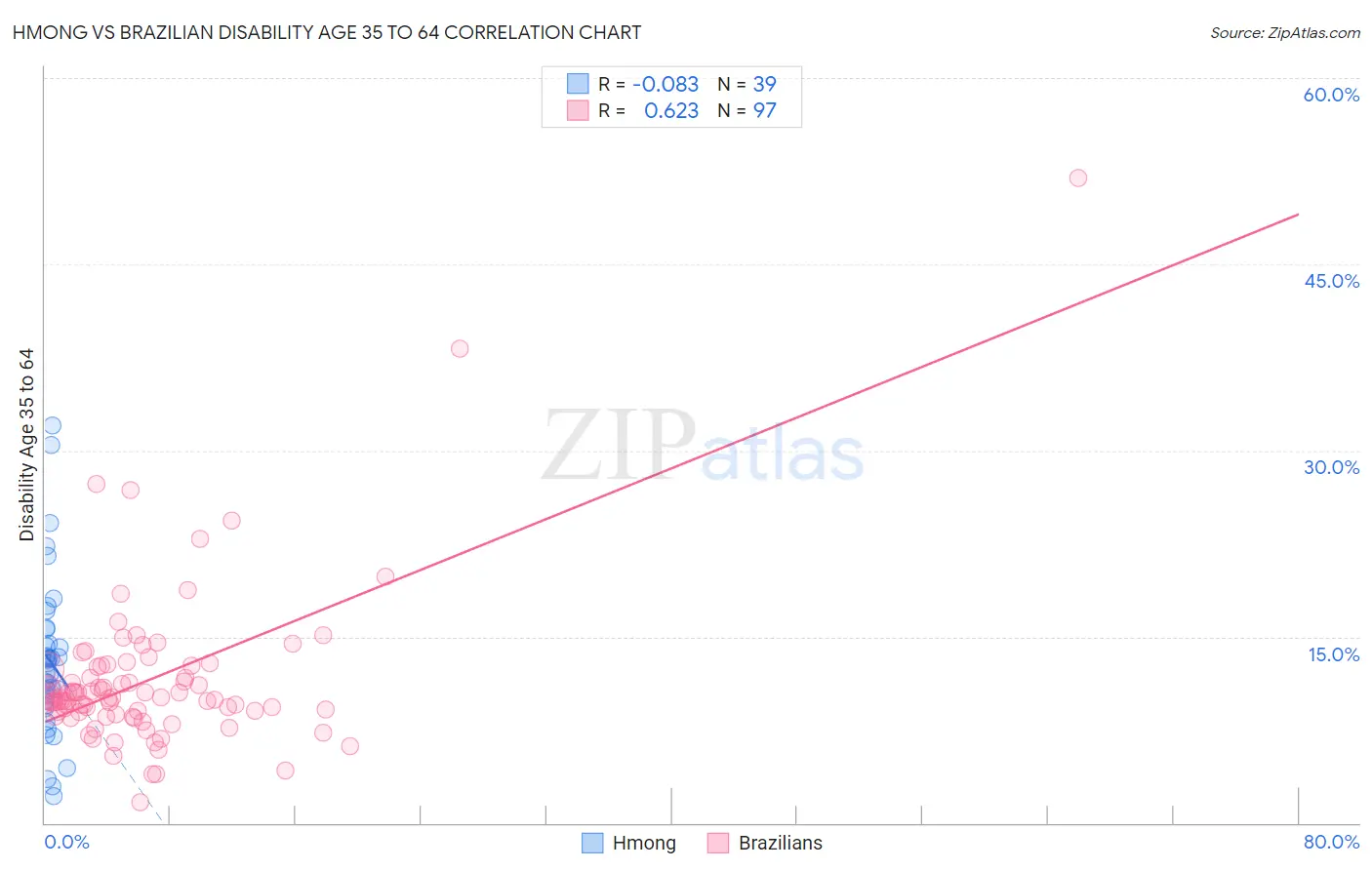Hmong vs Brazilian Disability Age 35 to 64
COMPARE
Hmong
Brazilian
Disability Age 35 to 64
Disability Age 35 to 64 Comparison
Hmong
Brazilians
13.1%
DISABILITY AGE 35 TO 64
0.0/ 100
METRIC RATING
286th/ 347
METRIC RANK
10.5%
DISABILITY AGE 35 TO 64
96.9/ 100
METRIC RATING
111th/ 347
METRIC RANK
Hmong vs Brazilian Disability Age 35 to 64 Correlation Chart
The statistical analysis conducted on geographies consisting of 24,678,157 people shows a slight negative correlation between the proportion of Hmong and percentage of population with a disability between the ages 34 and 64 in the United States with a correlation coefficient (R) of -0.083 and weighted average of 13.1%. Similarly, the statistical analysis conducted on geographies consisting of 323,696,465 people shows a significant positive correlation between the proportion of Brazilians and percentage of population with a disability between the ages 34 and 64 in the United States with a correlation coefficient (R) of 0.623 and weighted average of 10.5%, a difference of 25.2%.

Disability Age 35 to 64 Correlation Summary
| Measurement | Hmong | Brazilian |
| Minimum | 2.1% | 1.7% |
| Maximum | 32.0% | 51.9% |
| Range | 29.9% | 50.2% |
| Mean | 13.1% | 11.6% |
| Median | 12.9% | 10.1% |
| Interquartile 25% (IQ1) | 9.4% | 8.8% |
| Interquartile 75% (IQ3) | 15.6% | 12.6% |
| Interquartile Range (IQR) | 6.2% | 3.8% |
| Standard Deviation (Sample) | 6.5% | 6.6% |
| Standard Deviation (Population) | 6.4% | 6.5% |
Similar Demographics by Disability Age 35 to 64
Demographics Similar to Hmong by Disability Age 35 to 64
In terms of disability age 35 to 64, the demographic groups most similar to Hmong are Tlingit-Haida (13.2%, a difference of 0.27%), Immigrants from Somalia (13.1%, a difference of 0.31%), Fijian (13.2%, a difference of 0.62%), Indonesian (13.2%, a difference of 0.69%), and Nonimmigrants (13.0%, a difference of 0.75%).
| Demographics | Rating | Rank | Disability Age 35 to 64 |
| Immigrants | Micronesia | 0.1 /100 | #279 | Tragic 12.9% |
| Liberians | 0.1 /100 | #280 | Tragic 12.9% |
| Scotch-Irish | 0.1 /100 | #281 | Tragic 13.0% |
| Immigrants | Laos | 0.1 /100 | #282 | Tragic 13.0% |
| Central American Indians | 0.0 /100 | #283 | Tragic 13.0% |
| Immigrants | Nonimmigrants | 0.0 /100 | #284 | Tragic 13.0% |
| Immigrants | Somalia | 0.0 /100 | #285 | Tragic 13.1% |
| Hmong | 0.0 /100 | #286 | Tragic 13.1% |
| Tlingit-Haida | 0.0 /100 | #287 | Tragic 13.2% |
| Fijians | 0.0 /100 | #288 | Tragic 13.2% |
| Indonesians | 0.0 /100 | #289 | Tragic 13.2% |
| Immigrants | Liberia | 0.0 /100 | #290 | Tragic 13.2% |
| Immigrants | Congo | 0.0 /100 | #291 | Tragic 13.3% |
| Puget Sound Salish | 0.0 /100 | #292 | Tragic 13.3% |
| Ute | 0.0 /100 | #293 | Tragic 13.4% |
Demographics Similar to Brazilians by Disability Age 35 to 64
In terms of disability age 35 to 64, the demographic groups most similar to Brazilians are Assyrian/Chaldean/Syriac (10.5%, a difference of 0.030%), Tongan (10.5%, a difference of 0.15%), Korean (10.5%, a difference of 0.20%), Immigrants from Morocco (10.5%, a difference of 0.20%), and Immigrants from Ethiopia (10.5%, a difference of 0.27%).
| Demographics | Rating | Rank | Disability Age 35 to 64 |
| Immigrants | Austria | 97.8 /100 | #104 | Exceptional 10.4% |
| Macedonians | 97.8 /100 | #105 | Exceptional 10.4% |
| Immigrants | Hungary | 97.6 /100 | #106 | Exceptional 10.4% |
| Zimbabweans | 97.4 /100 | #107 | Exceptional 10.4% |
| Ethiopians | 97.4 /100 | #108 | Exceptional 10.5% |
| Immigrants | Ethiopia | 97.2 /100 | #109 | Exceptional 10.5% |
| Koreans | 97.1 /100 | #110 | Exceptional 10.5% |
| Brazilians | 96.9 /100 | #111 | Exceptional 10.5% |
| Assyrians/Chaldeans/Syriacs | 96.8 /100 | #112 | Exceptional 10.5% |
| Tongans | 96.6 /100 | #113 | Exceptional 10.5% |
| Immigrants | Morocco | 96.6 /100 | #114 | Exceptional 10.5% |
| Immigrants | Netherlands | 96.3 /100 | #115 | Exceptional 10.5% |
| Immigrants | Nepal | 95.9 /100 | #116 | Exceptional 10.6% |
| Immigrants | South Eastern Asia | 95.7 /100 | #117 | Exceptional 10.6% |
| Immigrants | Moldova | 95.5 /100 | #118 | Exceptional 10.6% |